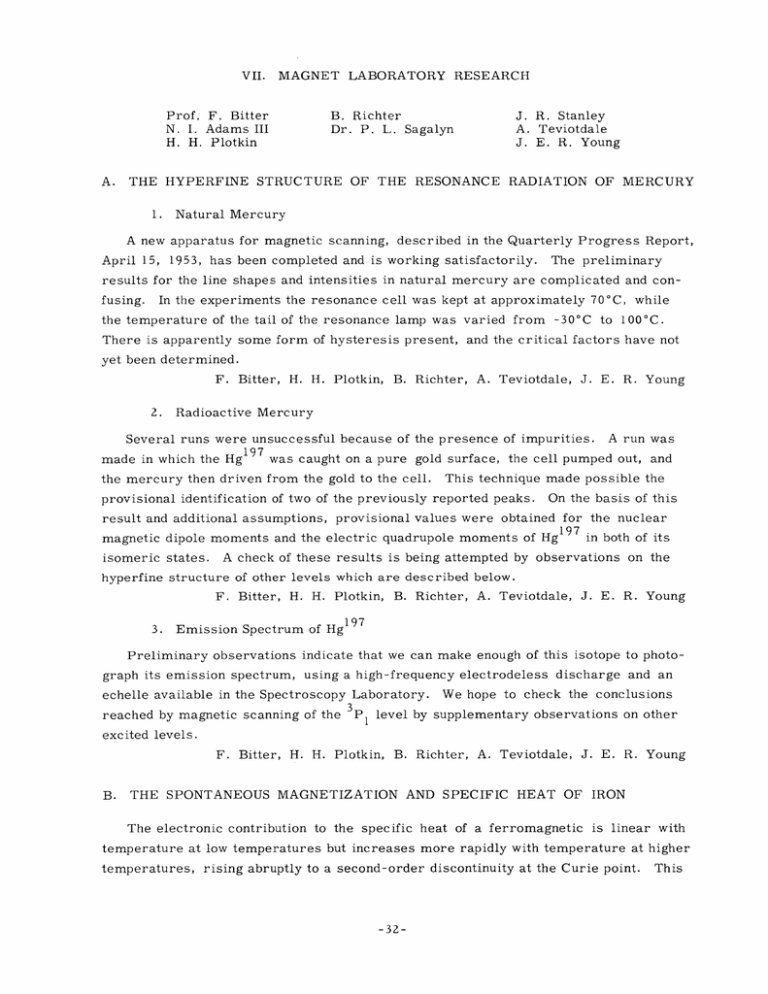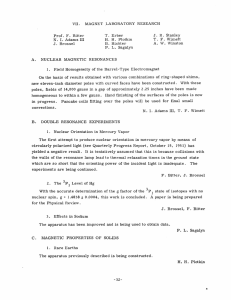VII. MAGNET LABORATORY RESEARCH Prof. F. Bitter
advertisement

VII. MAGNET LABORATORY RESEARCH Prof. F. Bitter N. I. Adams III H. H. Plotkin A. B. Richter Dr. P. L. Sagalyn THE HYPERFINE STRUCTURE 1. J. R. Stanley A. Teviotdale J. E. R. Young OF THE RESONANCE RADIATION OF MERCURY Natural Mercury A new apparatus for magnetic scanning, described in the Quarterly Progress Report, April 15, 1953, has been completed and is working satisfactorily. The preliminary results for the line shapes and intensities in natural mercury are complicated and conIn the experiments the resonance cell was kept at approximately 70 fusing. 0 C, while the temperature of the tail of the resonance lamp was varied from -30'C to 100°C. There is apparently some form of hysteresis present, and the critical factors have not yet been determined. F. 2. Bitter, H. H. Plotkin, B. Richter, A. Teviotdale, J. E. R. Young Radioactive Mercury Several runs were unsuccessful because of the presence of impurities. A run was 197 was caught on a pure gold surface, the cell pumped out, and made in which the Hg the mercury then driven from the gold to the cell. This technique made possible the provisional identification of two of the previously reported peaks. On the basis of this result and additional assumptions, provisional values were obtained for the nuclear magnetic dipole moments and the electric quadrupole moments of Hg isomeric states. 19 7 in both of its A check of these results is being attempted by observations on the hyperfine structure of other levels which are described below. F. 3. Bitter, H. H. Plotkin, B. Richter, A. Teviotdale, J. E. R. Young 97 Emission Spectrum of Hg1 Preliminary observations indicate that we can make enough of this isotope to photograph its emission spectrum, using a high-frequency electrodeless discharge and an echelle available in the Spectroscopy Laboratory. We hope to check the conclusions reached by magnetic scanning of the 3P1 level by supplementary observations on other excited levels. F. B. Bitter, H. H. Plotkin, B. Richter, A. Teviotdale, THE SPONTANEOUS MAGNETIZATION J. E. R. Young AND SPECIFIC HEAT OF IRON The electronic contribution to the specific heat of a ferromagnetic is linear with temperature at low temperatures but increases more rapidly with temperature at higher temperatures, rising abruptly to a second-order discontinuity at the Curie point. -32- This (VII. MAGNET LABORATORY RESEARCH) behavior is attributed partly to the kinetic energy of the free or quasi-free electrons, which accounts for the low-temperature linear term, and the "quasi-magnetic" or exchange energy EM of the electrons, which accounts for the abrupt rise to the Curie point. Stoner (1, 2) gives expressions for the specific heat and the spontaneous magnet- ization in terms of certain interaction parameters for a Fermi-Dirac assembly of electrons, assuming a band of standard form, but agreement with experiment is not good. It has recently been suggested (3) that the cause of this disagreement is the assumption that the exchange energy depends only on the square of the magnetization and that higherorder terms should be included. poorer agreement for iron (5), We have obtained fair agreement for nickel (4) and using an energy expression of the form k EM = where 0' is an interaction parameter, positive constant. agreement. (1 + A ) (1) t is the relative magnetization, and A is a small The indications are that a more general expression would give better Independent evidence at low temperatures (5) indicates further that the density of states for iron is constant over the relevant energy range, and that a more appropriate value of A in this region would be negative. Computations to test these indications were made by first finding (with a band of rectangular form (6)) the form of E M to obtain agreement with the spontaneous magnetization (7) and then using this to calculate the specific heat. The parameters involved are n = kO'/E N. , where E is the Fermi energy, and the number of "holes" in the d-band, Though in detail the agreement is poor, there is general quantitative agreement as to order of magnitude and shape, and this may be regarded as satisfactory. (6) results are published in the form of a curve, Potter's and interpolation is inaccurate; the process of numerical differentiation to obtain the specific heat adds further to the inaccuracy. It is thought that the results give some support to the treatment given elsewhere for iron (5). The effective 0' shows a maximum at ,;w 0. 75 or T/0 - 0. 8. It is possible that this maximum is related to the maximum in the dilatation of iron (8) and the sharp change of slope in the elastic moduli (9) about this temperature. A. Teviotdale References 1. E. C. Stoner: Proc. Roy. Soc. 2. E. C. Stoner: Proc. 3. E. P. Wohlfarth: 4. K. L. Hunt: (London) A 165, 372, 1938 Roy. Soc. (London) A 169, 339, 1939 Phil. Mag. 40, 703, Proc. Roy. Soc. A 216, 1095, 103, 33- 1949 1953 (VII. MAGNET LABORATORY RESEARCH) References (continued) Doctoral Thesis, Department of Physics, University of Leeds, 5. A. Teviotdale: England, 1952 6. E. 7. H. H. Potter: 8. H. Esser, H. Eusterbrock: 9. K. Iokib6, S. P. Wohlfarth: Phil. Mag. 42, Proc. Sakai: 374, 1951 Roy. Soc. (London) A 146, 362, 1934 Arch. Eisenhuttenwesen 14, Sci. Rep. Tohoku University 10, -34- 341, 1, 1921 1941





